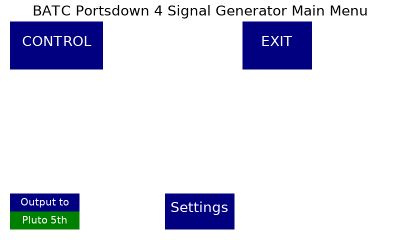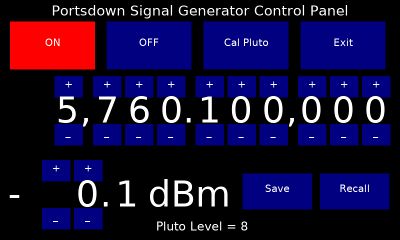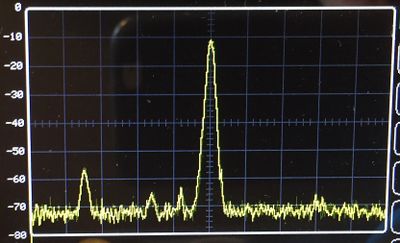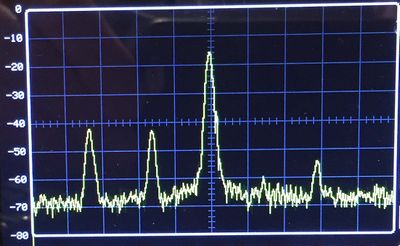Difference between revisions of "Portsdown 4 Signal Generator"
| Line 36: | Line 36: | ||
The software will also drive a NORT Synthesized Local Oscillator Microwave source within its operating range somewhere between 10 GHz and 14 GHz (depending on the model). Output level is fixed (generally at around +14 dBm). More information on the NORT SLO modules can be found here https://wiki.microwavers.org.uk/Nort_SLO. Pin connections: SPI Clock 29, SPI Data 31 and SPI Latch Enable 8. | The software will also drive a NORT Synthesized Local Oscillator Microwave source within its operating range somewhere between 10 GHz and 14 GHz (depending on the model). Output level is fixed (generally at around +14 dBm). More information on the NORT SLO modules can be found here https://wiki.microwavers.org.uk/Nort_SLO. Pin connections: SPI Clock 29, SPI Data 31 and SPI Latch Enable 8. | ||
| + | |||
| + | ===Controlling an ADF4135-based Synthesizer=== | ||
| + | |||
| + | The Portsdown 4 signal generator can also control an ADF4135-based Synthesizer. Pin connections: SPI Clock 29, SPI Data 31 and SPI Latch Enable 8. | ||
Revision as of 17:30, 19 May 2021
The Sig Gen is selected from a button on the top line of the Portsdown Menu 2. Selecting this takes you to the Sig Gen Menu. Here you can select the output device to use, a settings menu, or the main control page.
Using the Pluto as the Output Device
From the settings menu, you can enter the IP address of your Pluto (only required if you have changed it from 192.168.2.1), check and extend the frequency range of your Pluto, and set the reference frequency for the Pluto and the ADF 4351. Changing the Pluto reference frequency here will also correct it for use with the Langstone.
If you have Pluto selected as the output mode, you will need to calibrate it near the output frequency and power that you propose to use. So select those, MAKE SURE THAT NO SENSITIVE DEVICES ARE CONNECTED TO THE PLUTO OUTPUT, and press calibrate. You can then reconnect the output and the risk of power spikes is low after that. Frequency coverage is from 50 MHz to 6 GHz and the selectable output level is from a plus a few dBm down to about - 70 dBm (both frequency-dependent). The displayed output level is within about 1 dB on my 2 Plutos, and is corrected for the Pluto's frequency response. It is worth rebooting the Pluto (from the settings menu) before and after using it with the signal generator for accuracy and reliability.
Notes:
- The Pluto calibration produces a pulse of up to 10 dBm.
- If you have used the Pluto to transmit SSB or DATV since switch-on, it will need rebooting for use with the Sig Gen (either just the Pluto or the complete Portsdown with Pluto) to clear out the old settings
- The Pluto signal has a spurious 4 MHz below it at about -45 dB and 3 others (2 MHz below, 1 MHz below and 2 MHz above) at about -55 dB. Spectrum at 0 dBm 437 MHz shown below.
The 5th Harmonic from the Pluto can also be used as a weak signal source for testing Microwave Receivers up to 30 GHz. Simply select Pluto 5th Harmonic as the output device. The output level is very low (typically max -33 dBm at 10 GHz) and is not calibrated. Again, there are spurii at - 4MHz (-27 dB), -2 MHz (-28 dB), +2 MHz (-46 dB) and +4 MHz (-40 dB). The spectrum below is at 10368 MHz.
Credits go to Alberto Ferraris IU1KVL (of Satsagen fame) for his plutotx software and to Robin Getz for his comments on that software. Thanks also to Colin G4EML for doing the initial investigations on Pluto 5th Harmonic mode.
Using the DATV Express as the Output Device
Similarly, a DATV Express board can be used as an output device. The frequency range is 70 MHz to 2450 MHz and the level from about +10 dBm to -30 dBm. No calibration is required and you can apply 333kS QPSK modulation to check PA linearity.
Using an ADF4351 Module as the Output Device
To use an ADF4351, it needs to be connected to the GPIO pins as specified here [url]https://wiki.batc.org.uk/Portsdown_4_GPIO_Connections[/url]. It will cover from 35 MHz to 4.4 GHz, but only has 4 output levels, 3 dB spaced, around -5 dBm.
Using an Elcom Microwave Source as the Output Device
The software will also drive an Elcom Microwave source within its operating range somewhere between 10 GHz and 14 GHz (depending on the model). Output level is fixed (generally at around +10 dBm). More information can be found on the Elcom modules here https://wiki.microwavers.org.uk/24_GHz#Elcom_synthesisers.
Using an NORT Synthesized Local Oscillator Microwave Source as the Output Device
The software will also drive a NORT Synthesized Local Oscillator Microwave source within its operating range somewhere between 10 GHz and 14 GHz (depending on the model). Output level is fixed (generally at around +14 dBm). More information on the NORT SLO modules can be found here https://wiki.microwavers.org.uk/Nort_SLO. Pin connections: SPI Clock 29, SPI Data 31 and SPI Latch Enable 8.
Controlling an ADF4135-based Synthesizer
The Portsdown 4 signal generator can also control an ADF4135-based Synthesizer. Pin connections: SPI Clock 29, SPI Data 31 and SPI Latch Enable 8.



